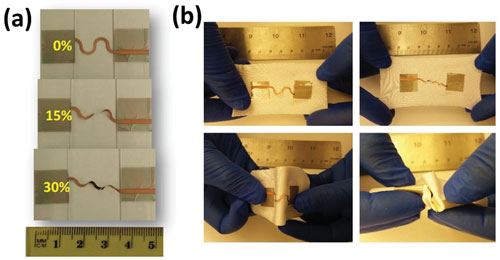| Posted: Oct 09, 2015 | |
A stretchable far-field communication antenna far wearable electronics |
|
| (Nanowerk Spotlight) The age of wearable electronics is upon us as witnessed by the fast growing array of smart watches, fitness bands and other advanced, next-generation health monitoring devices such as electronic stick-on tattoos (see for instance "wearing single-walled carbon nanotube electronics on your skin", a "temporary tattoo to monitor glucose levels" or "graphene nanosensor tattoo on teeth monitors bacteria in your mouth"). | |
| In order for these wearable sensor devices to become fully integrated into sophisticated monitoring systems, they require wireless interfaces to external communication devices such as smartphones. This requires far-field communication systems that, like the sensor systems, perform even under extreme deformations and during extended periods of normal daily activities. | |
| "While the transistors used in radio frequency (RF) circuits can be made flexible and stretchable using several techniques already demonstrated, the main component of the communication circuit, the antenna for far-field communication, is still a challenge," Muhammad Mustafa Hussain, an Associate Professor of Electrical Engineering at KAUST, tells Nanowerk. | |
| To complement existing designs for stretchable antenna systems – which usually radiate at different resonant frequencies and are expensive due to the complex processing involved or the exotic materials used – an international team led by Hussain now demonstrates a stretchable and wearable antenna that can provide a single frequency operation while flexing or stretching. | |
| The group of researchers, which included KAUST Assistant Prof. Atif Shamim and Swanlund Chair Professor John Rogers of University of Illinois at Urbana Champaign, reports their findings in the October 6, 2015 online edition of Advanced Functional Materials ("Metal/Polymer Based Stretchable Antenna for Constant Frequency Far-Field Communication in Wearable Electronics"). The paper will be the front cover article of the print edition. | |
 |
|
| Optical images of the antenna-on-fabric show that it can be strained, bent, twisted and curled along with the fabric without physical damage. (Reprinted with permission by Wiley-VCH Verlag) (click on image to enlarge) | |
| The team's flexible and stretchable metal thin-film (copper) antenna for far-field communication – up to 80 meters while mounted on a stretchable fabric and worn by a person – maintains its properties during stretching, bending and strain cycles. | |
| "We fabricated our antenna using a metal/polymer bilayer process – the resulting structure combines the conductivity of the metal and the elasticity of the polymer – and the stretchability is imparted using a lateral spring structure," explains Aftab Hussain, a PhD candidate in Hussain's lab and the paper's first author. "The key reason the antenna needed to be fabricated as a metal/ polymer bilayer is that standalone metal thin films are very malleable, and deform plastically under application of stress." | |
| That means that a metal thin film lateral spring structure cannot be used as a stretchable antenna, since it will only be able to undergo one stretch cycle. | |
| The solution to this problem was to use a polymer backing that provides the restoration force which helps the spring return to its original shape after the release of the applied lateral force. | |
| As a result, the key performance parameters of the antenna do not change with bending, stretching, flexing and twisting – hence the antenna can continuously communicate information in the WiFi frequency band while it is worn. | |
| In their tests, the researchers found that their antenna retains all its essential properties such as gain, radiation pattern, directionality, operation frequency and bandwidth for up to 30% strain and for 2000 stretching cycles. | |
| As a next step, the team will integrate their stretchable antenna into a fully integrated, flexible, stretchable and wearable sensor array for real-time communication of sensor information. | |
 By
Michael
Berger
– Michael is author of three books by the Royal Society of Chemistry:
Nano-Society: Pushing the Boundaries of Technology,
Nanotechnology: The Future is Tiny, and
Nanoengineering: The Skills and Tools Making Technology Invisible
Copyright ©
Nanowerk LLC
By
Michael
Berger
– Michael is author of three books by the Royal Society of Chemistry:
Nano-Society: Pushing the Boundaries of Technology,
Nanotechnology: The Future is Tiny, and
Nanoengineering: The Skills and Tools Making Technology Invisible
Copyright ©
Nanowerk LLC
|
|
|
Become a Spotlight guest author! Join our large and growing group of guest contributors. Have you just published a scientific paper or have other exciting developments to share with the nanotechnology community? Here is how to publish on nanowerk.com. |
|
